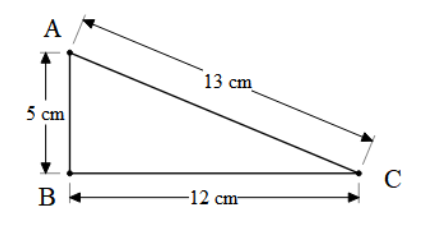
Find the area of the triangle with 5cm, 12cm, 13cm.
Answer
577.8k+ views
Hint: We need to find which kind of triangle it is. We can check if the triangle is right angle triangle or not by checking the Pythagoras theorem. The Pythagoras theorem says that ${{\left( \text{Hypotenuse} \right)}^{\text{2}}}\text{=}{{\left( \text{Base} \right)}^{\text{2}}}\text{+}{{\left( \text{Height} \right)}^{\text{2}}}$ . The hypotenuse is always the biggest side in the triangle.
Complete step-by-step answer:
If the triangle is right angle triangle then the area of the triangle is given by $A=\dfrac{1}{2}\times \text{Base }\!\!\times\!\!\text{ Height}$ .

We need to find the area of this triangle.
Let’s assume the triangle ABC with sides AB = 5cm, BC = 12cm, and AC = 13 cm.
Let’s first check whether the triangle is right angle triangle or not.
We can check this with the help of the Pythagoras theorem.
The Pythagoras theorem is only applicable for the right-angle triangle.
Therefore, if the Pythagoras theorem is satisfied then we can say that the triangle is right-angled.
The Pythagoras theorem says that ${{\left( \text{Hypotenuse} \right)}^{\text{2}}}\text{=}{{\left( \text{Base} \right)}^{\text{2}}}\text{+}{{\left( \text{Height} \right)}^{\text{2}}}$ .
The hypotenuse is always the biggest side in the triangle.
Substituting the values, we get,
$\begin{align}
& {{\left( 13 \right)}^{2}}={{\left( 5 \right)}^{2}}+{{\left( 12 \right)}^{2}} \\
& 169=25+144 \\
& 169=169 \\
\end{align}$
Thus, we can see that equality holds that means that the triangle ABC is right-angled.
As we can see that, $\angle ABC={{90}^{\circ }}$ ,
Therefore, the area of the right-angle triangle (A) is given by,
$A=\dfrac{1}{2}\times \text{Base }\!\!\times\!\!\text{ Height}........\text{(i)}$
We can say that Height = AB = 5cm and Base = BC = 12cm.
Substituting the value in equation (i), we get,
$\begin{align}
& A=\dfrac{1}{2}\times 5\times 12 \\
& =5\times 6 \\
& =30c{{m}^{2}}
\end{align}$
Therefore, the area of the triangle with sides 5cm, 12cm, 13cm is $30c{{m}^{2}}$.
Note: The calculation of the area of the right-angle triangle is easiest. In other cases, we need to drop the perpendicular on the base of the triangle and then calculate the area. In the right-angle triangle, one side is already perpendicular to one of the sides. We can also see that the 5, 12, 13 is a Pythagorean triplet, the other Pythagorean triplets are 3, 4, 5. This means that any triangle with sides of Pythagorean triplets is always a right angle triangle.
Complete step-by-step answer:
If the triangle is right angle triangle then the area of the triangle is given by $A=\dfrac{1}{2}\times \text{Base }\!\!\times\!\!\text{ Height}$ .

We need to find the area of this triangle.
Let’s assume the triangle ABC with sides AB = 5cm, BC = 12cm, and AC = 13 cm.
Let’s first check whether the triangle is right angle triangle or not.
We can check this with the help of the Pythagoras theorem.
The Pythagoras theorem is only applicable for the right-angle triangle.
Therefore, if the Pythagoras theorem is satisfied then we can say that the triangle is right-angled.
The Pythagoras theorem says that ${{\left( \text{Hypotenuse} \right)}^{\text{2}}}\text{=}{{\left( \text{Base} \right)}^{\text{2}}}\text{+}{{\left( \text{Height} \right)}^{\text{2}}}$ .
The hypotenuse is always the biggest side in the triangle.
Substituting the values, we get,
$\begin{align}
& {{\left( 13 \right)}^{2}}={{\left( 5 \right)}^{2}}+{{\left( 12 \right)}^{2}} \\
& 169=25+144 \\
& 169=169 \\
\end{align}$
Thus, we can see that equality holds that means that the triangle ABC is right-angled.
As we can see that, $\angle ABC={{90}^{\circ }}$ ,
Therefore, the area of the right-angle triangle (A) is given by,
$A=\dfrac{1}{2}\times \text{Base }\!\!\times\!\!\text{ Height}........\text{(i)}$
We can say that Height = AB = 5cm and Base = BC = 12cm.
Substituting the value in equation (i), we get,
$\begin{align}
& A=\dfrac{1}{2}\times 5\times 12 \\
& =5\times 6 \\
& =30c{{m}^{2}}
\end{align}$
Therefore, the area of the triangle with sides 5cm, 12cm, 13cm is $30c{{m}^{2}}$.
Note: The calculation of the area of the right-angle triangle is easiest. In other cases, we need to drop the perpendicular on the base of the triangle and then calculate the area. In the right-angle triangle, one side is already perpendicular to one of the sides. We can also see that the 5, 12, 13 is a Pythagorean triplet, the other Pythagorean triplets are 3, 4, 5. This means that any triangle with sides of Pythagorean triplets is always a right angle triangle.
Recently Updated Pages
Master Class 12 Business Studies: Engaging Questions & Answers for Success

Master Class 12 Economics: Engaging Questions & Answers for Success

Master Class 12 English: Engaging Questions & Answers for Success

Master Class 12 Maths: Engaging Questions & Answers for Success

Master Class 12 Social Science: Engaging Questions & Answers for Success

Master Class 12 Chemistry: Engaging Questions & Answers for Success

Trending doubts
Who was the first woman to receive Bharat Ratna?

Write a letter to the principal requesting him to grant class 10 english CBSE

Why is there a time difference of about 5 hours between class 10 social science CBSE

What is the median of the first 10 natural numbers class 10 maths CBSE

The Equation xxx + 2 is Satisfied when x is Equal to Class 10 Maths

Discuss the main reasons for poverty in India




